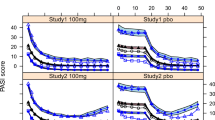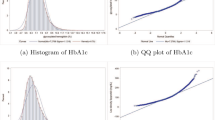Abstract
Disease status is often measured with bounded outcome scores (BOS) which takes a discrete set of values on a finite range. The distribution of such data is often skewed, rendering the standard analysis methods assuming normal distribution inappropriate. Among the methods used for BOS analyses, two of them have the ability to predict the data within its natural range and accommodate data skewness: (1) a recently proposed beta-distribution based approach and (2) a mixture model known as CUB (combined uniform and binomial). This manuscript compares the two approaches, using an established mechanism-based longitudinal exposure-response model to analyze data from a phase 2 clinical trial in psoriatic patients. The beta-distribution–based approach was confirmed to perform well, and CUB also showed potential. A separate issue of modeling clinical trial data is that the collected baseline disease score range may be more limited than that of post-treatment disease score due to clinical trial inclusion criteria, a fact that is typically ignored in longitudinal modeling. The effect of baseline disease status restriction should in principle be adjusted for in longitudinal modeling.






Similar content being viewed by others
References
Overgaard RV, Ingwersen SH, Tornoe CW. Establishing good practices for exposure-response analysis of clinical endpoints in drug development. CPT Pharmacometrics Syst Pharmacol. 2015;4(10):565–75.
Hu C, Zhou H, Sharma A. Landmark and longitudinal exposure-response analyses in drug development. J Pharmacokinet Pharmacodyn. 2017;44(5):503–7.
Lesaffre E, Rizopoulos D, Tsonaka R. The logistic transform for bounded outcome scores. Biostatistics. 2007;8(1):72–85.
Zhou H, Hu C, Zhu Y, Lu M, Liao S, Yeilding N, et al. Population-based exposure-efficacy modeling of ustekinumab in patients with moderate to severe plaque psoriasis. J Clin Pharmacol. 2010;50(3):257–67.
Hu C, Randazzo B, Sharma A, Zhou H. Improvement in latent variable indirect response modeling of multiple categorical clinical endpoints: application to modeling of guselkumab treatment effects in psoriatic patients. J Pharmacokinet Pharmacodyn. 2017;44(5):437–48.
Iannario MP, D. A comprehensive framework of regression models for ordinal data. METRON. 2016;74(2):233–52.
Hu C. On the comparison of methods in analyzing bounded outcome score data. AAPS J. 2019;21(6):102.
Ursino M, Gasparini M. A new parsimonious model for ordinal longitudinal data with application to subjective evaluations of a gastrointestinal disease. Stat Methods Med Res. 2018;27(5):1376–93.
Hu C, Zhou H, Sharma A. Applying Beta distribution in analyzing bounded outcome score data. AAPS J. 2020;22(3):61.
Piccolo D, Simone R, Iannario M. Cumulative and CUB models for rating data: a comparative analysis. Int Stat Rev. 2019;87(2):207–36.
Sharma A, Jusko WJ. Characterization of four basic models of indirect pharmacodynamic responses. J Pharmacokinet Biopharm. 1996;24(6):611–35.
Hu C, Szapary PO, Mendelsohn AM, Zhou H. Latent variable indirect response joint modeling of a continuous and a categorical clinical endpoint. J Pharmacokinet Pharmacodyn. 2014;41(4):335–49.
Hutmacher MM, Krishnaswami S, Kowalski KG. Exposure-response modeling using latent variables for the efficacy of a JAK3 inhibitor administered to rheumatoid arthritis patients. J Pharmacokinet Pharmacodyn. 2008;35:139–57.
Hu C. Exposure-response modeling of clinical end points using latent variable indirect response models. CPT Pharmacometrics Syst Pharmacol. 2014;3:e117.
Hu C, Zhou H. Improvement in latent variable indirect response joint modeling of a continuous and a categorical clinical endpoint in rheumatoid arthritis. J Pharmacokinet Pharmacodyn. 2016;43(1):45–54.
Hu C, Adedokun OJ, Chen Y, Szapary PO, Gasink C, Sharma A, et al. Challenges in longitudinal exposure-response modeling of data from complex study designs: a case study of modeling CDAI score for ustekinumab in patients with Crohn's disease. J Pharmacokinet Pharmacodyn. 2017;44(5):425–36.
Hu C, Adedokun OJ, Zhang L, Sharma A, Zhou H. Modeling near-continuous clinical endpoint as categorical: application to longitudinal exposure-response modeling of Mayo scores for golimumab in patients with ulcerative colitis. J Pharmacokinet Pharmacodyn. 2018;45(6):803–16.
Hu C, Xu Y, Zhuang Y, Hsu B, Sharma A, Xu Z, et al. Joint longitudinal model development: application to exposure-response modeling of ACR and DAS scores in rheumatoid arthritis patients treated with sirukumab. J Pharmacokinet Pharmacodyn. 2018;45(5):679–91.
Hu C, Yao Z, Chen Y, Randazzo B, Zhang L, Xu Z, et al. A comprehensive evaluation of exposure-response relationships in clinical trials: application to support guselkumab dose selection for patients with psoriasis. J Pharmacokinet Pharmacodyn. 2018;45(4):523–35.
Hu C, Zhou H, Sharma A. Facilitating longitudinal exposure-response modeling of a composite endpoint using the joint modeling of sparsely and frequently collected subcomponents. AAPS J. to appear.
Krueger GG, Langley RG, Leonardi C, Yeilding N, Guzzo C, Wang Y, et al. A human interleukin-12/23 monoclonal antibody for the treatment of psoriasis. N Engl J Med. 2007;356(6):580–92.
Hu C, Zhou H. An improved approach for confirmatory phase III population pharmacokinetic analysis. J Clin Pharmacol. 2008;48(7):812–22.
Hu C, Zhang J, Zhou H. Confirmatory analysis for phase III population pharmacokinetics. Pharm Stat. 2011;10(1):14–26.
Zhu Y, Hu C, Lu M, Liao S, Marini J, Yohrling J, et al. Population pharmacokinetic modeling of ustekinumab, a human monoclonal antibody targeting il-12/23p40, in patients with moderate to severe plaque psoriasis, J Clin Pharmacol. 2009;49(2):162–75.
Hutmacher MM, French JL, Krishnaswami S, Menon S. Estimating transformations for repeated measures modeling of continuous bounded outcome data. Stat Med. 2011;30(9):935–49.
Hu C, Xu Z, Mendelsohn A, Zhou H. Latent variable indirect response modeling of categorical endpoints representing change from baseline. J Pharmacokinet Pharmacodyn. 2013;40(1):81–91.
Zhang L, Beal SL, Sheiner LB. Simultaneous vs. sequential analysis for population PK/PD data I: best-case performance. J Pharmacokinet Pharmacodyn. 2003;30(6):387–404.
Beal SL, Sheiner LB, Boeckmann A, Bauer RJ. NONMEM user's guides (1989–2009). Ellicott City: Icon Development Solutions; 2009.
Bauer RJ. NONMEM tutorial part II: estimation methods and advanced examples. CPT Pharmacometrics Syst Pharmacol. 2019;8(8):538–56.
Karlsson MO, Holford NHG. A tutorial on visual predictive checks 2008 [updated 2008. Available from: www.page-meeting.org/?abstract=1434.
Funding
This research was funded by Janssen Research and Development, LLC.
Author information
Authors and Affiliations
Corresponding author
Additional information
Publisher’s Note
Springer Nature remains neutral with regard to jurisdictional claims in published maps and institutional affiliations.
Rights and permissions
About this article
Cite this article
Hu, C., Zhou, H. & Sharma, A. Application of Beta-Distribution and Combined Uniform and Binomial Methods in Longitudinal Modeling of Bounded Outcome Score Data. AAPS J 22, 95 (2020). https://doi.org/10.1208/s12248-020-00478-5
Received:
Accepted:
Published:
DOI: https://doi.org/10.1208/s12248-020-00478-5




